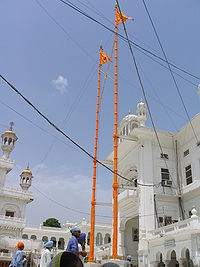The Sikh place of worship is called a Gurdwara which means gateway to the Guru. All persons regardless of religion, race, ethnicity gender and background are welcome to visit insde without any form of discrimination. Infact Sikhism so strongly emphasises equality and onesness of humanity that Gurdwaras always have 4 doors, one on each side of the buiding to symbolise all people equal and welcome.
The first gurdwara was built in Kartarpur, on the banks of Ravi River in the Punjab region by the first Sikh guru, Guru Nanak Dev in the year 1521. It now lies in the Narowal District of west Punjab (Pakistan).
The worship centres were built as a place where Sikhs could gather to hear the guru give spiritual discourse and sing religious hymns in the praise of Waheguru. As the Sikh population continued to grow, Guru Hargobind, the sixth Sikh guru, introduced the word gurdwara.
The etymology of the term gurdwara is from the words gur (ਗੁਰ) (a reference to the Sikh gurus) and dwara (ਦੁਆਰਾ) (gateway in Gurmukhi), together meaning ‘the gateway through which the guru could be reached’. Thereafter, all Sikh places of worship came to be known as gurdwaras.
Some of the prominent Sikh shrines established by the Sikh gurus are:
- Nankana Sahib, established in the 1490s by first Sikh Guru, Guru Nanak Dev, Punjab, Pakistan.
- Sultanpur Lodhi, established in 1499 became the Sikh centre during Guru Nanak Dev time Kapurthala District, Punjab (India).
- Kartarpur Sahib, established in 1521 by the first Sikh Guru, Guru Nanak Dev, near River Ravi, Narowal, Punjab, Pakistan.
- Khadur Sahib, established in 1539 by the second Sikh Guru, Guru Angad Dev ji, near River Beas, Amritsar District, Punjab, India.
- Goindwal Sahib, established in 1552 by the third Sikh Guru, Guru Amar Das ji, near River Beas, Amritsar District Punjab, India.
- Sri Amritsar, established in 1577 By the fourth Sikh Guru, Guru Ram Das ji, District Amritsar, Punjab India.
- Tarn Taran Sahib, established in 1590 by the fifth Sikh Guru, [Guru Arjan Dev ji], District Tarn Taran Sahib, Punjab India.
- Kartarpur Sahib, established in 1594 by the fifth Sikh Guru, Guru Arjan Dev, near river Beas, Jalandhar District, Punjab India.
- Sri Hargobindpur, established by the fifth Sikh Guru, Guru Arjan Dev, near river Beas, Gurdaspur District, Punjab India.
- Kiratpur Sahib, established in 1627 by the sixth Sikh Guru, Guru Hargobind, near river Sutlej, Ropar District, Punjab, India.
- Anandpur Sahib, established in 1665 by the ninth Sikh Guru, Guru Tegh Bahadur, near river Sutlej, Punjab, India.
- Paonta Sahib, established in 1685 by the tenth Sikh Guru, Guru Gobind Singh, near river Yamuna, Himachal Pradesh India.
By the early 20th century, a number of Sikh gurdwaras in British India were under the control of the Udasi mahants (clergymen).[5] The Gurdwara Reform Movement of the 1920s resulted in Shiromani Gurdwara Parbandhak Committee taking control of these gurdwaras.

